Federal Fire Service Salary Structure 2023 – The federal fire service has its own pay scale separate from other government agencies. As a federal firefighter, your salary depends on your grade level and years of service.
Below are some Clearfield details on the federal fire service salary structure.
The federal Fire Service salary structure
The Federal Fire Service has a structured pay scale for firefighters based on rank and years of service. As a firefighter, your salary will increase over time through pay raises and promotions.
-
Chief Inspector (CI) – receives one million four hundred five thousand four hundred forty-nine (1,405,449) naira per year
-
Deputy Chief Inspector (DCI) – receives about one million three hundred twenty-five thousand two hundred thirty-four (1,325,234) naira yearly
-
Assistant Chief Inspector (ACI) – receives one million two hundred fifty-two thousand thirty-eight (1,252,038) naira per year
-
Principal Marshal Inspector (PMI) – receives one million one hundred forty-three thousand five hundred thirty-nine (1,143,539) naira per year
-
Senior Marshal Inspector (SMI) – receives one million fifty-eight thousand four hundred sixteen (1,058,416) naira per year
-
Marshal Inspector I (MI-I) – earn about seven hundred seventy-seven thousand eight hundred seventy-six (777,876) naira yearly
-
Marshal Inspector II (MI-II) – receives five hundred forty-eight thousand three hundred eighty-seven (548,387) naira per year
-
Marshal Inspector III (MI-III) – receives about three hundred ninety-three thousand four hundred forty-two (393,442) naira per year
-
Chief Fire Marshal Assistant (CFMA) – earn about nine hundred sixty-six thousand seven hundred sixty-one (966,761) naira yearly
-
Deputy Fire Marshal Assistant (DFMA) – receives five hundred thirty-nine thousand forty-eight (539,048) naira per year
-
Senior Fire Marshal Assistant (SFMA) – receives three hundred eighty-seven thousand four hundred twenty-eight (387,428) naira per year
-
Fire Marshal Assistant I (FMA I) – receives three hundred forty-nine thousand five hundred eighty-nine (349,589) naira per year
-
Fire Marshal Assistant II (FMA II) – receives three hundred nineteen thousand seven hundred forty-one (319,741) naira per year
-
Fire Marshal Assistant III (FMA III) – earn three hundred five thousand five hundred seventy-six (305,576) naira yearly.
The federal government also provides generous benefits like health insurance, retirement plans, paid time off, and tuition reimbursement. Firefighters can retire with a full pension after 20–30 years of service.
As you gain more experience, you will have opportunities for special assignments that provide higher pay. These assignments include training instructors, fire investigators, or public educators. Firefighters also earn additional pay for paramedic certification, hazardous materials training, or bilingual skills.
With dedication and time, you can have a long and rewarding career as a federal firefighter. The salary structure rewards your commitment to public service with regular pay increases and advancement into leadership roles over the years.
- Delta State MOBSE Recruitment
- NIMC Recruitment Form
- Akwa Ibom SUBEB Recruitment
- NIS Recruitment Form
- AEDC Recruitment Portal
- EFCC Recruitment Application Process
- FJSC Recruitment
The benefits of The federal Fire Service salary structure
The Federal Fire Service offers many benefits in addition to competitive pay. Some of the major benefits include:
1. Healthcare
As a federal firefighter, you will have access to health insurance through the Federal Employees Health Benefits (FEHB) program. This comprehensive program offers medical, dental, and vision coverage for both you and your family. One of the notable advantages of this program is that the government contributes a significant portion towards the premiums, resulting in relatively low out-of-pocket costs for you.
2. Retirement
Federal firefighters are covered by the Federal Employees Retirement System (FERS). This includes a pension, a Thrift Savings Plan (TSP) similar to a 401(k), and Social Security benefits. The government matches your TSP contributions up to 5% of your salary. Firefighters can retire in their early to mid-50s with a full pension and benefits.
3. Leave
Vacation Leave
Federal Fire Service employees are entitled to receive paid vacation leave. The number of vacation days accrued increases with years of service, rewarding our dedicated employees who have been in service for longer periods. Vacation earnings are calculated based on employee years in service, qualifications, proficiency, and rank in service and awarded annually.
Sick Leave
In addition to vacation leave, all employees have sick leave. Unlike vacation leave, federal fire service employees are entitled to sick leave.
Paid Federal Holidays
Federal Fire Service recognizes and celebrates federal holidays. Therefore, we provide our employees with 10 paid federal holidays per year. These holidays include but are not limited to, New Year’s Day, Independence Day
4. Job security
Federal firefighters have a stable and secure job environment. The difficulty of being fired, combined with the potential for a lifelong career until retirement, makes it an attractive profession for those seeking stability and job security. By maintaining acceptable performance and conduct, aspiring federal firefighters can enjoy a fulfilling and rewarding career while contributing to public safety.
5. Opportunities for advancement
There are many opportunities for career progression as a federal firefighter. You can be promoted to engineer, captain, battalion chief and other leadership roles based on your experience, skills, and performance.
You can also pursue additional training and certifications to advance into specialized areas like wildland firefighting, hazardous materials response, paramedics, etc.
Find out if the Federal Fire Service (FFS) are recruiting by clicking on www.fedfire.gov.ng official portal.
Conclusion
Federal firefighters enjoy excellent compensation and benefits. Competitive pay, affordable healthcare and insurance for your family. You also have a generous retirement plan, paid leave and holidays, high job security, and many career growth opportunities.
